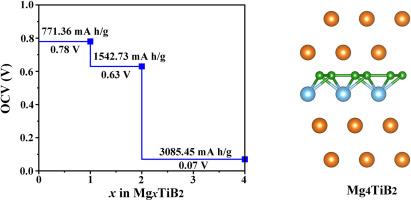2D TiB2 monolayer as a promising anode material for high-performance magnesium-ion batteries
IF 3
4区 生物学
Q2 BIOCHEMICAL RESEARCH METHODS
引用次数: 0
Abstract
The design and fabrication of high-performance anode materials are pivotal in advancing the development of next-generation magnesium-ion batteries (MIBs). Herein, we conducted a comprehensive first-principles calculation to investigate the structure properties and electronic characteristics of the emerging TiB2 monolayer, and further evaluate its potential as an anode material of MIBs. Our computational results reveal that the TiB2 anode exhibits intrinsic metallic behavior and demonstrates a strong affinity for Mg ions with a notably low adsorption energy of −1.39 eV. Utilizing the crystal orbital Hamiltonian population analysis, it is found that the Mg-B bonds show distinct ionic bonding characteristics and dominate the interactions within Mg ion – TiB2 anode interface. Mg ions can diffuse rapidly on the TiB2 anode surface with a low diffusion barrier of 0.05 eV, which implies an excellent charging-discharge rate. Moreover, the efficient Mg adsorption on the two sides of TiB2 anode leads to a high storage capacity of 3085.45 mA h/g and a low average open-circuit voltage of 0.39 V, superior to many reported 2D materials. The TiB2 anode further demonstrates excellent thermal stability and tiny lattice change during the electrochemical cycling process, which is of paramount importance for achieving a prolonged cycle life. These exceptional properties reveal that TiB2 monolayer is an appealing anode candidate for high-performance MIBs.

二维TiB2单层膜作为高性能镁离子电池极具前景的负极材料
高性能负极材料的设计和制造是推进下一代镁离子电池发展的关键。在此,我们进行了全面的第一性原理计算,以研究新兴的TiB2单层的结构特性和电子特性,并进一步评估其作为mib阳极材料的潜力。我们的计算结果表明,TiB2阳极表现出固有的金属行为,对Mg离子具有很强的亲和力,吸附能很低,为- 1.39 eV。利用晶体轨道哈密顿居群分析发现,Mg- b键表现出明显的离子键特征,并主导着Mg离子- TiB2阳极界面内的相互作用。Mg离子在TiB2阳极表面快速扩散,扩散势垒较低,为0.05 eV,具有良好的充放电速率。此外,TiB2阳极两侧对Mg的有效吸附使其具有3085.45 mA h/g的高存储容量和0.39 V的低平均开路电压,优于许多报道的2D材料。在电化学循环过程中,TiB2阳极进一步表现出优异的热稳定性和微小的晶格变化,这对延长循环寿命至关重要。这些特殊的性质表明,TiB2单层膜是高性能mib极具吸引力的阳极候选材料。
本文章由计算机程序翻译,如有差异,请以英文原文为准。
求助全文
约1分钟内获得全文
求助全文
来源期刊

Journal of molecular graphics & modelling
生物-计算机:跨学科应用
CiteScore
5.50
自引率
6.90%
发文量
216
审稿时长
35 days
期刊介绍:
The Journal of Molecular Graphics and Modelling is devoted to the publication of papers on the uses of computers in theoretical investigations of molecular structure, function, interaction, and design. The scope of the journal includes all aspects of molecular modeling and computational chemistry, including, for instance, the study of molecular shape and properties, molecular simulations, protein and polymer engineering, drug design, materials design, structure-activity and structure-property relationships, database mining, and compound library design.
As a primary research journal, JMGM seeks to bring new knowledge to the attention of our readers. As such, submissions to the journal need to not only report results, but must draw conclusions and explore implications of the work presented. Authors are strongly encouraged to bear this in mind when preparing manuscripts. Routine applications of standard modelling approaches, providing only very limited new scientific insight, will not meet our criteria for publication. Reproducibility of reported calculations is an important issue. Wherever possible, we urge authors to enhance their papers with Supplementary Data, for example, in QSAR studies machine-readable versions of molecular datasets or in the development of new force-field parameters versions of the topology and force field parameter files. Routine applications of existing methods that do not lead to genuinely new insight will not be considered.
 求助内容:
求助内容: 应助结果提醒方式:
应助结果提醒方式:


